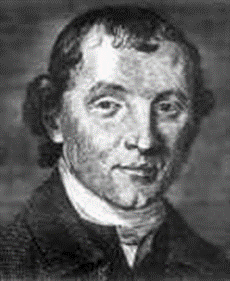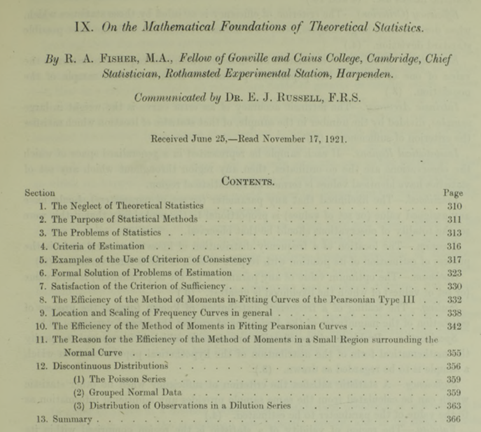
The History of Statistics IG brings together individuals and groups with an active interest in the history of statistics, to share research and resources.
How to get URL link on X (Twitter) App



 2/‘Simpsons Rule’ 1743 for estimating definite integrals was actually developed 100 years earlier by Johannes Kepler (Keplersche Fassregel), with versions by Bonaventura Cavalieri (a student of Galileo) in 1639, & James Gregory 1668
2/‘Simpsons Rule’ 1743 for estimating definite integrals was actually developed 100 years earlier by Johannes Kepler (Keplersche Fassregel), with versions by Bonaventura Cavalieri (a student of Galileo) in 1639, & James Gregory 1668


 2/First to publicize the Tuskegee Syphilis Study (“the most unethical study in US history”) in the Drum (an anti-discrimination newsletter) but was ignored. In 1972, Peter Buxtun of PHS leaked the story to the Associated Press where it made front page news
2/First to publicize the Tuskegee Syphilis Study (“the most unethical study in US history”) in the Drum (an anti-discrimination newsletter) but was ignored. In 1972, Peter Buxtun of PHS leaked the story to the Associated Press where it made front page news

 2/ Spearheaded reforms in medical research reliability & reporting [see .] With Martin Bland he published numerous highly cited papers on statistical methodology targeted primarily to non-statistician end users.equator-network.org
2/ Spearheaded reforms in medical research reliability & reporting [see .] With Martin Bland he published numerous highly cited papers on statistical methodology targeted primarily to non-statistician end users.equator-network.org


 2/Called “a distinguished mathematician of great erudition and integrity” her contributions were in both pure & applied maths. She was the first female invited speaker at International Congress of Mathematicians 1912.
2/Called “a distinguished mathematician of great erudition and integrity” her contributions were in both pure & applied maths. She was the first female invited speaker at International Congress of Mathematicians 1912. 

 2/ He proposed a unifying theory of statistics, with the focus on problems of estimation & distribution. However Fisher being Fisher, he begins with a jab at Karl Pearson.
2/ He proposed a unifying theory of statistics, with the focus on problems of estimation & distribution. However Fisher being Fisher, he begins with a jab at Karl Pearson.


 2/ He probably studied mathematics with James Gregory 1720-1 & became introduced to probability either directly from de Moivre (who hung out in London coffeeshops discussing probability) or after reading Simpson 1755.
2/ He probably studied mathematics with James Gregory 1720-1 & became introduced to probability either directly from de Moivre (who hung out in London coffeeshops discussing probability) or after reading Simpson 1755.

 2/ He broke with tradition by using statistical methods to summarize empirical patterns of between-group differences, rather than try to find universal laws of society that would mimic those of physical science.
2/ He broke with tradition by using statistical methods to summarize empirical patterns of between-group differences, rather than try to find universal laws of society that would mimic those of physical science.

 2/ Fisher being Fisher he begins with a jab at Karl Pearson. He then proposes a unifying theory of statistics, with the focus on problems of estimation & distribution.
2/ Fisher being Fisher he begins with a jab at Karl Pearson. He then proposes a unifying theory of statistics, with the focus on problems of estimation & distribution.

 2/ He preferred statistics to abstract mathematics which he disliked, so he left graduate school in Michigan for UC Berkeley to work with Jerzy Neyman. The most famous story about him is the basis for the story line of the movie “Good Will Hunting”
2/ He preferred statistics to abstract mathematics which he disliked, so he left graduate school in Michigan for UC Berkeley to work with Jerzy Neyman. The most famous story about him is the basis for the story line of the movie “Good Will Hunting” 

 2/ Back when smoking seemed to be a "normal & harmless habit" they began a prospective study of British doctors & their smoking habits that lasted 50 years (Doll himself quit smoking during this study)
2/ Back when smoking seemed to be a "normal & harmless habit" they began a prospective study of British doctors & their smoking habits that lasted 50 years (Doll himself quit smoking during this study)

 2/However his major contributions were to clinical trial design (esp randomisation), safety data review & trial ethics. At a time when randomisation was regarded w suspicion he was a tireless promoter of the central importance of what Peto calls ‘randomised evidence”
2/However his major contributions were to clinical trial design (esp randomisation), safety data review & trial ethics. At a time when randomisation was regarded w suspicion he was a tireless promoter of the central importance of what Peto calls ‘randomised evidence”

 2/ He proposed 3x the probable error of the normal curve. This would be roughly a one-sided p-value of 0.02 (1 in 50 odds), because probable error is ~0.67456 of a standard deviation.
2/ He proposed 3x the probable error of the normal curve. This would be roughly a one-sided p-value of 0.02 (1 in 50 odds), because probable error is ~0.67456 of a standard deviation.

 2/“properties of correlation coefficient & Professor Pearson's types of frequency curves".
2/“properties of correlation coefficient & Professor Pearson's types of frequency curves". 


 2/ Guinness had almost doubled beer production between 1887 & 1914 so consistent quality was a concern. The problem was determining how representative a small sample might be of the whole batch. Gosset was assigned to the problem because he had taken maths at Oxford
2/ Guinness had almost doubled beer production between 1887 & 1914 so consistent quality was a concern. The problem was determining how representative a small sample might be of the whole batch. Gosset was assigned to the problem because he had taken maths at Oxford

 2/ He needed to measure the population to “gauge the progress of European colonization” & implement policies to diversify the economy & strengthen governance.
2/ He needed to measure the population to “gauge the progress of European colonization” & implement policies to diversify the economy & strengthen governance.


 2/ She was the first ever female invited speaker at International Congress of Mathematicians 1912 where she read a paper on curved surfaces. Semple called her “a distinguished mathematician of great erudition and integrity”.
2/ She was the first ever female invited speaker at International Congress of Mathematicians 1912 where she read a paper on curved surfaces. Semple called her “a distinguished mathematician of great erudition and integrity”. 


 2/ As well as highly entertaining criticisms of his foes, the paper also presents derivations & distribution data for a variety of biological data, including human skulls, crab ‘foreheads’, shell lengths, & organ weights.
2/ As well as highly entertaining criticisms of his foes, the paper also presents derivations & distribution data for a variety of biological data, including human skulls, crab ‘foreheads’, shell lengths, & organ weights. 

 2/ He collaborated throughout the 1950s with other notable statisticians such as CR Rao Fisher Shewart & was sponsored by Tukey at Princeton
2/ He collaborated throughout the 1950s with other notable statisticians such as CR Rao Fisher Shewart & was sponsored by Tukey at Princeton


 2/ Reviews were cool (which incensed him): there were a lot of mistakes in the first edition, the amount of hand calculation was formidable, & he seemed to underestimate the difficulties for most researchers in their application.
2/ Reviews were cool (which incensed him): there were a lot of mistakes in the first edition, the amount of hand calculation was formidable, & he seemed to underestimate the difficulties for most researchers in their application.


 was almost forgotten by the end of the 19th c. He learned how ‘le calcul des probabilités’ could be applied during a debate in 1835 at the Académie des Sciences, where Navier (of Navier-Stokes equation fame) described how it could be applied to therapeutic research 2/7
was almost forgotten by the end of the 19th c. He learned how ‘le calcul des probabilités’ could be applied during a debate in 1835 at the Académie des Sciences, where Navier (of Navier-Stokes equation fame) described how it could be applied to therapeutic research 2/7 